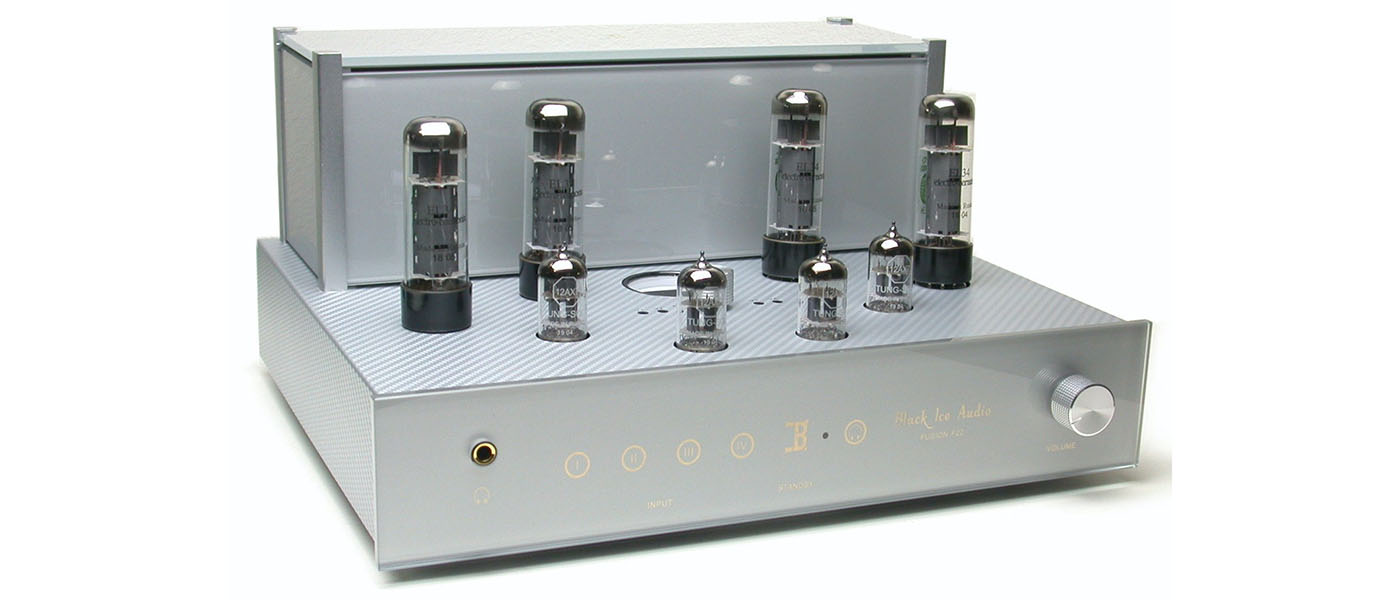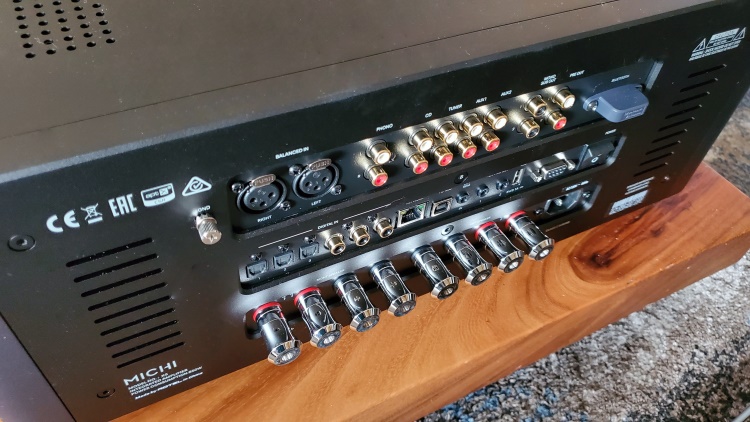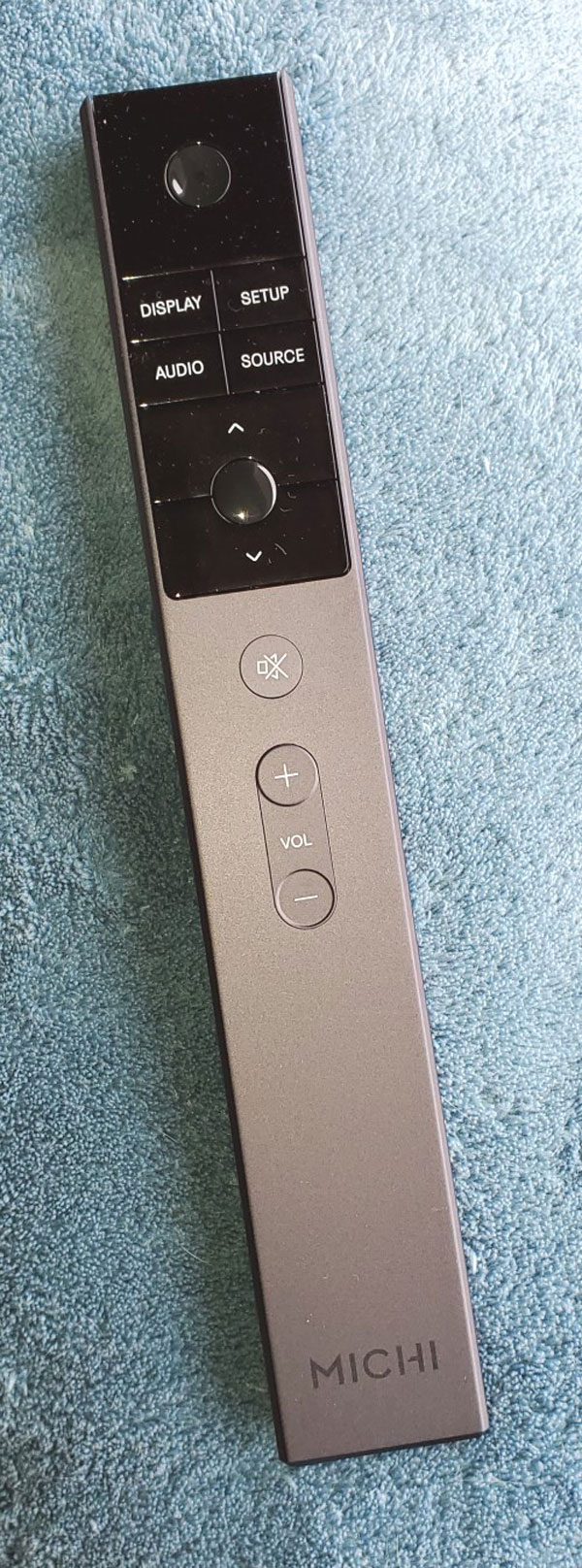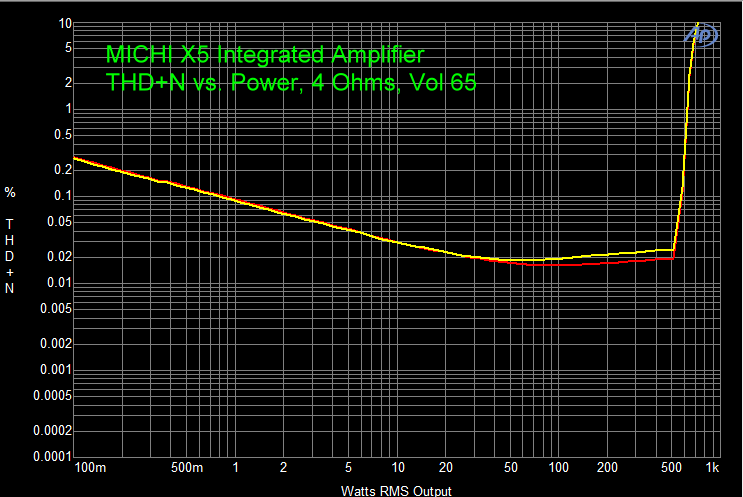
Rotel is a fixture in the world of consumer electronics and a respected one. There is a current trend where such manufacturers decide to create a line of products where they pull out all the stops. Their huge amount of experience allows them to do this with ease. No corners are cut either in parts quality or build. The result is expensive but worth it. That is the essence of their new MICHI X5 Integrated Amplifier.
MICHI X5 Integrated Amplifier
- Plenty of wattage output
- Large Power Supply
- Lots of different inputs
- Excellent parts quality
- Musical personality
- High quality to cost ratio
Rotel has been around a long time. The predecessors of the company existed in the 1950s, and they organized into Rotel in 1961. Rotel is wholly owned and independent as a Japanese family-owned business. Rotel and Bower & Wilkins (Classé) share history with the distribution of Rotel through B&W subsidiaries in multiple countries and cooperation in manufacturing B&W and Classé products in the Rotel factory ~2016.
Secrets Sponsor
Obviously, they have had tremendous experience with all sorts of audio components.
Rotel originally launched the MICHI brand in 1993 as their statement, spare-no-expense, line of products. While the products were universally praised, the MICHI brand faded away as we entered into the new century. Recently, the brand has been revived and Rotel has officially returned to the high-end market with the new MICHI line. This line is very expensive, but that does not scare an audiophile. We expect to pay for the quality that we demand. It is not rocket science. Massive build, the highest quality parts, and circuit design based on nearly a century of experience. The results? You will see.
We reviewed the MICHI X3 a few months ago. It is similar to the X5 but has 200 watts output per channel (two channels) into 8 Ohms compared to the X5’s 350 watts per channel.
CONTINUOUS POWER OUTPUT:
600W/Ch (4Ω)
350W/Ch (8Ω)
FREQUENCY RESPONSE:
Line Level Inputs: 10 Hz – 100 kHz (+0 dB, -0.6 dB)
Digital Inputs: 20 Hz – 20 kHz (0 ± 0.4 dB)
Phono Input: 20 Hz – 20k Hz (+0 dB, -0.2 dB)
TOTAL HARMONIC DISTORTION (THD):
<0.009%
S/N RATIO (IHF “A” Weighted):
Line Level Inputs: 102 dB
Digital Inputs: 102 dB
Phono Input: 80 dB
INTERMODULATION DISTORTION (60 Hz:7 kHz, 4:1):
<0.03%
DAMPING FACTOR (20 Hz – 20 kHz, 8 Ohms):
350
CHANNEL SEPARATION:
>65 dB
INPUT SENSITIVITY:
Line Level Inputs (RCA): 380 mV
Line Level Inputs (XLR): 580 mV
Phono Input (MM): 5.7 mV
Phono Input (MC): 570 uV
INPUT IMPEDANCE:
Line Level Inputs (RCA): 100 kΩ
Line Level Inputs (XLR): 100 kΩ
Digital Inputs: 75Ω
Phono Input (MM): 47 kΩ
Phono Input (MC): 100 Ω
INPUT Maximum:
Line Level Inputs (RCA): 12.5 V
Line Level Inputs (XLR): 12.5 V
Phono Input (MM): 197 mV
Phono Input (MC): 19 mV
PRE OUT LEVEL:
1 V
OUTPUT IMPEDANCE:
470 Ω
TONE CONTROLS:
±10 dB at 100 Hz / 10 kHz
COAX/OPTICAL DIGITAL INPUT SIGNALS:
SPDIF LPCM (Up to 24-bit/192 kHz)
PC-USB:
USB Audio Class 1 (up to 24/96)
USB Audio Class 2 (up to 32/384)
MQA, DSD, and DoP support
DIMENSIONS (W × H × D):
19 ” x 7 5/8″ x 17 3/4″
485 x 195 x 452 mm
FRONT PANEL HEIGHT:
132 mm (5 1/4″)
POWER REQUIREMENTS:
120 V, 60 Hz
POWER CONSUMPTION:
850 W
STANDBY POWER CONSUMPTION:
<0.5 W
NET WEIGHT:
96.56 lbs. (43.8 kg)
BTU RATING:
2194 BTU/h
MSRP:
$6,999 USD (£6300)
Website:
Company Directory:
SECRETS Tags:
Rotel, MICHI, MICHI X5, MICHI X5 Integrated Amplifier, Integrated amplifier, amplifier review, review 2021
The MICHI X5 Integrated Amplifier is a Class A/B design (the MICHI P5 Preamplifier utilizes a symmetrical balanced Class A circuit). The X5 contains Qty:4 BHC (British Engineered) 100 V, 22,000 µF capacitors totaling 88,000 µF of bulk storage and ripple smoothing capacitors.
The X5 utilizes four Burr-Brown OPA1641 single-channel op-amps with 0.00005% THD+N. These are exceptional op-amps that have speed and noise levels rivaling some Class A circuits. They are used in the input stages.
The inside of the chassis is shown below. Large transformers and large capacitors are always a good sign. The X5 weighs close to 100 pounds.
![]()
For efficiency of size, thermal design, and performance, the X5 crosses over to Class B at 1 watt. This ensures the integrity of the audio and provides the fanless, passive cooling of this amplifier to be maintenance-free and completely silent in operation.
The amplifier is driven by six pairs of MN1526 / MP1526 high current ON Semiconductor BiPolar output devices per channel for a total of twenty-four output devices.
The rear panel has a full range of inputs, analog and digital. One pair of XLR balanced analog inputs is included. There are four sets of speaker binding posts, so you can bi-wire if you like. The posts are massive, some of the heaviest I have ever seen.
There are tone controls: ± 10 dB at 100 Hz and ± 10 dB at 10 kHz.
The remote control is simple and elegant. Using the arrow keys you can select the various options from the display on the front panel. You can adjust the volume and mute it if your phone rings.
For my listening, I utilized a computer output through a Lynx laboratory-grade fully balanced analog sound card, the XLR balanced input on the MICHI X5, and Carver Platinum Mark IV Ribbon Speakers. The cables were Clarus Audio and Wireworld. I also used a Clarus Concerto Power Conditioner with Crimson Power Cable.
Complete List of Reference Components: OPPO BDP-105 Universal Player (4), OPPO UDP-205 Universal Player (2), VPI-HR-X Turntable with Sumiko Blackbird MC Cartridge and Sumiko Palo Santos MC Cartridge, AURALiC ALTAIR G1 Digital Audio Streamer, Manley Labs Steelhead Tube Phono Preamplifier (2), Balanced Audio Technology VK-5i Pure Class A Triode (Tube) Stereo Preamplifier (2) (Fully Balanced), Balanced Audio Technology VK-500 Solid State Stereo Power Amplifier (Fully Balanced) (250 Watts per Channel), Pass Labs Xs Preamplifier, Pass Labs Xs 300 Monoblock Pure Class A Power Amplifiers (2) (300 Watts/each), Parasound JC 1+ Monoblock Power Amplifiers (2), Lamm LL1 Signature Stereo Pure Class A Triode (Tube) Preamplifier, MartinLogan CLX Full-Range Electrostatic Speakers (2), Sonus faber Lilium Speakers (2), Paradigm Reference Signature SUB 2 Subwoofers (2), Custom-Built Computer for Audio Analysis, Accupel HDG-3000 Digital Color Signal Generator (1080i capable), Component Video and DVI Output, ColorFacts Pro Video Test and Calibration Software, Version 6.0, Spyder Sensor, SpectraPlus Audio Analysis Software, Audio Precision SYS-2722
Spectrum Analyzer, Staco 3PN2210B-DVM 22 Ampere Variable Transformer (for adjusting line voltage to 120 volts during amplifier power output tests), Pass Labs XP-20 Stereo Preamplifier, Classé SSP-800 Surround Sound Processor, Emotiva XMC-1 Surround Sound Processor, Classé CA-5200 Five-Channel Power Amplifier (200 Watts per Channel), Pass Labs X600.8 Power Amplifiers (4) (600 Watts/Each), Audio Control Phase Coupled Activator (Sub-Harmonic Generator), Carver Platinum Mark IV Ribbon Speakers (2), MartinLogan Summit X Hybrid Electrostatic Speakers (2) (Rear Left/Right), MartinLogan Stage X Hybrid Electrostatic Speakers (3) (Center and Sides Left/Right), MartinLogan Balanced Force 212 Subwoofer, Velodyne DD-18+ Subwoofer (3), HiFiMAN HE1000 Planar Magnetic Headphones, OPPO PM-1 Planar Magnetic Headphones, OPPO HA-1 Headphone Amplifier, Bryston BUC-1 USB Converter, Sony VPL-HW55ES 1,920 x 1,080p Digital Projector, 90″ (Diagonal) Stewart Grayhawk Projection Screen, Sony 75″ UHD (4K) Flat Panel Display, Clarus Audio and Wireworld cables, Clarus Concerto Power Conditioner with Crimson Power Cable
Overall, the MICHI X5 presented a very musical listening experience. It has, as you will see, a little more distortion than some amplifiers that I have tested, but the harmonics are still quite low. They add the “musicality” that I am referring to.

Music – Johann Sebastian Bach: The Complete Works for Keyboard, Vol. 4 “Alla Veneziana” – Benjamin Alard – Harmonia Mundi – Released 1-14-2021
Harpsichord makes an excellent test for audio equipment because there are a lot of high frequencies and complex note structures as well as so many keys being played at the same time.
This new release of J. S. Bach’s complete works for keyboard is beautifully recorded and played. The complexity of the music was aptly displayed by the MICHI X5. High frequencies are not for relaxation. I prefer piano for that. When I listen to the harpsichord, I am paying attention, not trying to drift off into a netherworld. For this album, I had one of my cats on my lap and a cup of my favorite afternoon drink, hot chocolate.
The “sting” of the harpsichord was there. That is produced by the plucking of the strings when a key is depressed, compared to a piano where the string is struck by a padded hammer. The sound has this sting because of sharp initial transients.

Music – Pelham Humfrey: Sacred Choral Music – The Choir of Her Majesty’s Chapel Royal – Delphian – Released 1-21-2021
Where would we be without human voices in a product review? This new album of choral music is a good one for that kind of test. Multiple voices along with soloists. Very sweet and musical. This amplifier has quite a personality!
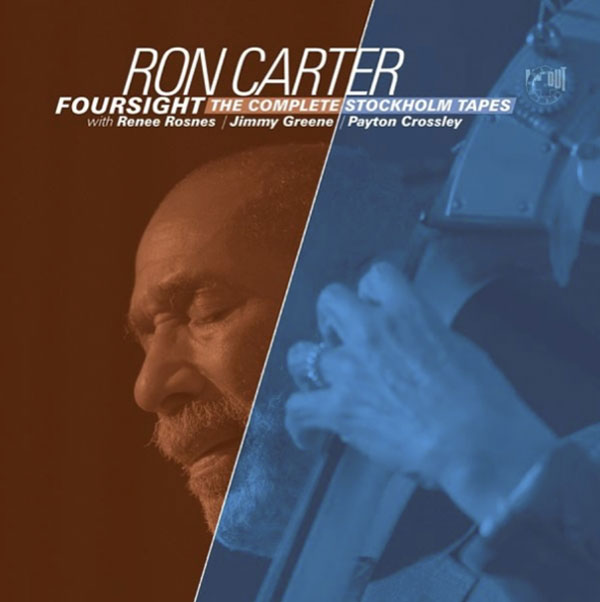
Music – Ron Carter – Foursight: The Complete Stockholm Tapes – IN+OUT Records – Released 1-21-2021
Ron Carter is among the most original, prolific, and influential bassists in jazz. With more than 2,000 albums to his credit, he has recorded with many of music’s greats: Tommy Flanagan, Gil Evans, Lena Horne, Bill Evans, B.B. King, the Kronos Quartet, Dexter Gordon, Wes Montgomery, and Bobby Timmons. In the early 1960s, he performed throughout the United States in concert halls and nightclubs with Jaki Byard and Eric Dolphy.
He later toured Europe with Cannonball Adderley. From 1963 to 1968, he was a member of the classic and acclaimed Miles Davis Quintet. He was named Outstanding Bassist of the Decade by the Detroit News, Jazz Bassist of the Year by Downbeat magazine, and Most Valuable Player by the National Academy of Recording Arts and Sciences. In 1993 Ron Carter earned a Grammy award for Best Jazz Instrumental Group, the Miles Davis Tribute Band, and another Grammy in 1998 for Call ‘Sheet Blues’, an instrumental composition from the film ‘Round Midnight. (© Manhattan School of Music)
Carter was born in 1937, and he is still active.

Photo 1980 © Wikipedia: https://en.wikipedia.org/wiki/Ron_Carter
As some of you know, I am a huge fan of classic jazz. There were ten styles of classic jazz from 1917 to 1967 My favorite jazz is from the 1950s to somewhere around 1970.
Ron Carter is a perfect example of why I (and millions of others) are fans of music from this era. His career began in about 1960.
The music is complex, yet so listenable. There aren’t that many bassists where albums focus on them. This guy is one of those.
Tenor sax takes up most of the melody lines, but occasionally, Ron plays a solo, and one can see why he is so famous. The sax’ raspy sound came through clearly. This is caused by the reed in the instrument being wet. And, Carter’s twangy double bass was extraordinary. The sheen of the ride cymbal and crack of the snare – terrific!
The X5 did him justice.
The interesting thing about the Stockholm tapes is that the recordings are from around 2018. However, the style is definitely classic. The title says “Tapes”, but I don’t know if the recordings are actually from tape. I hope so. The vinyl version of this album is almost $100 on Amazon.

Music – Taylor Swift – the “dropped your hand while dancing” chapter – Released 1-20-2021
Taylor Swift is one of our most popular Pop stars. This is her latest release. She must have the microphone only an inch or two from her mouth. I can hear her breathing as well as singing. Maybe a new feature on amplifiers could be turning the clarity down by softening the leading-edge transients. The X5 hides nothing.

Music – Wonder Woman 1984 (Soundtrack) – WaterTower Music – Released 12-15-2020
I remember when soundtracks were recordings of full orchestras, real orchestras. Now, a huge portion of it is electronic music. I haven’t seen this movie, but I like movie soundtracks, so I thought I would listen to this one. All I can say is that current soundtracks make full use of an audio system’s capabilities. The MICHI X5 had some extreme demands placed upon it, and it delivered. Even when I cranked the volume, the intense sounds were very articulate. I was not subjected to audible distortion except when it was part of the electronic sound effects.
Using a 1 kHz sine wave at 2.2 Volts input, 8 Ohms load (0.6 watts), THD+N was 0.029%. Yellow is the left channel spectrum and red is the right channel.
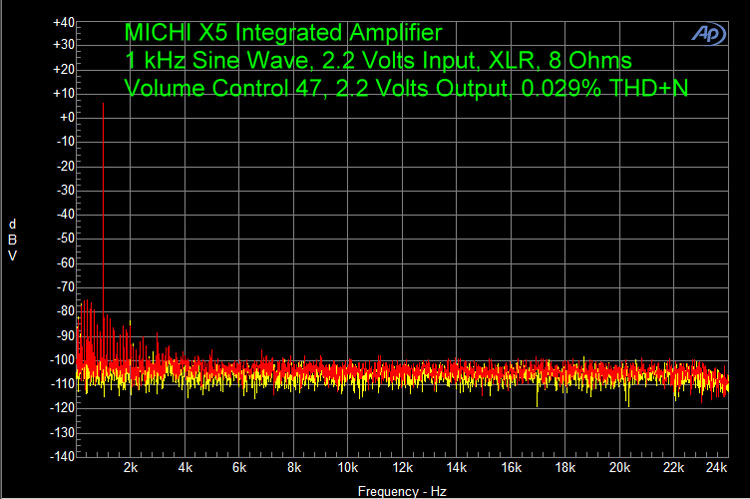
With 50 watts into 8 Ohms, THD+N was 0.008%. Notice that there are many more peaks with the 50 watts output than with 0.6 watts output, but distortion is lower. That is because, even with more distortion peaks, the percentage of the output that is distortion is lower. That is why one has to not consider the distortion number absolute.
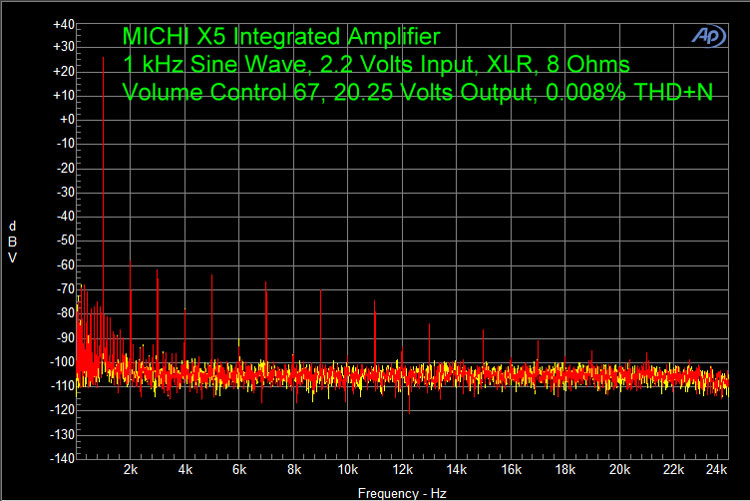
At a 4 Ohms load, 2.1 volts output (1.1 watts), distortion was 0.31%. Distortion usually rises at 4 Ohms compared to 8.
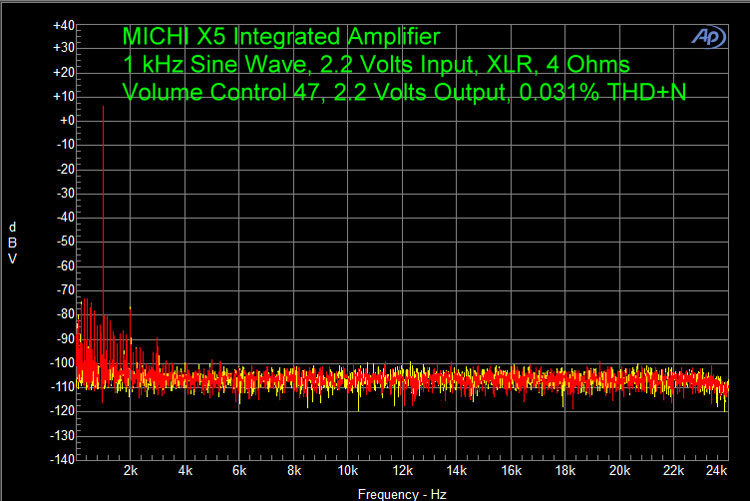
And, at 20 Volts into 4 Ohms (103 watts), distortion was less (0.015%) than at 1.1 watts (0.031%) even though there were many more peaks at 103 watts. Again, this is due to the percentage. Notice that at 103 watts into 4 Ohms, which is a stressful load, the primary distortion peak is 2nd order. This is why the X5 has a musical personality.
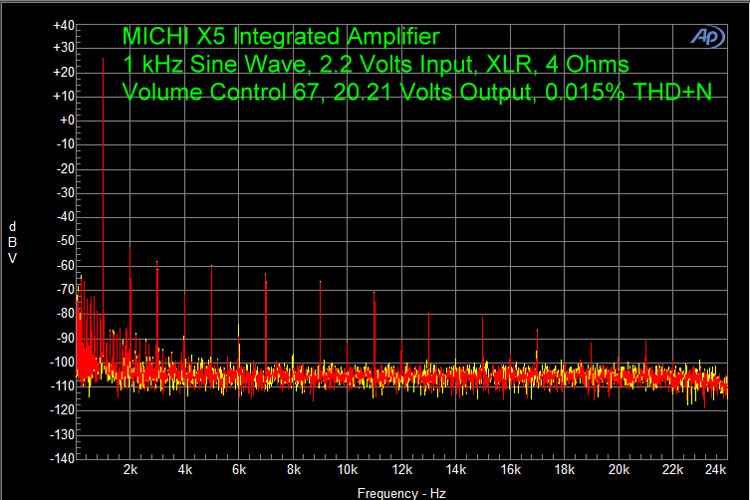
Let’s take a look at a hum spectrum. This one shows the hum peaks with a 20.25 Volt 1 kHz sine wave into 8 Ohms. You can see peaks at 60 Hz, 120 Hz, 180 Hz, 240 Hz, etc.
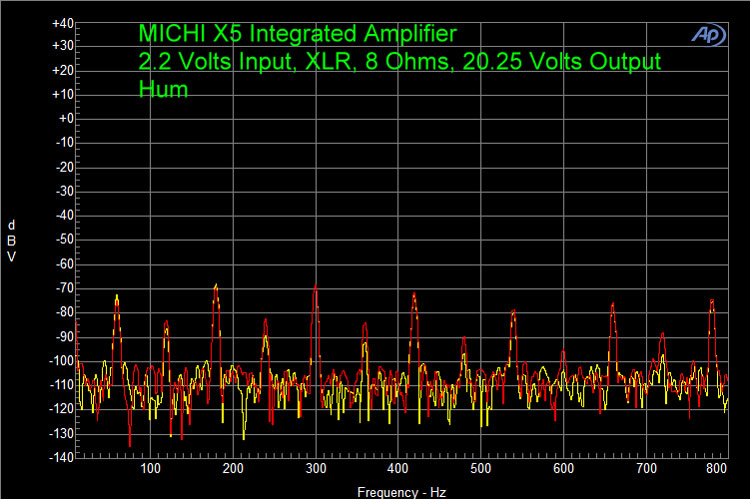
Using the same settings, but with the input signal turned off, see below. The even-ordered hum peaks (120 Hz, 240 Hz, etc.) are much lower. So, the higher even-ordered hum peaks only appear when there is an input signal. I haven’t seen this phenomenon discussed before, so for now, it will just be a curiosity. Because the peaks are so low (-80 dBV), I don’t think they are audible.
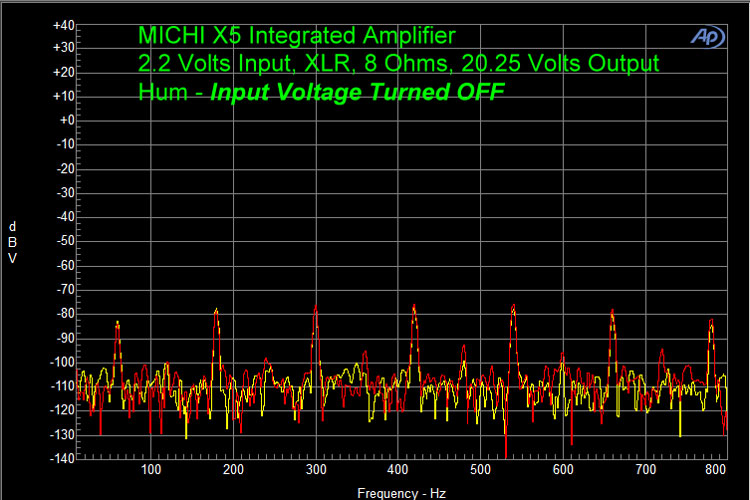
Going to intermodulation examination, and using 19 kHz and 20 kHz sine waves, here is the spectrum with 2 Volts into 8 Ohms. There are only two IM peaks, one on either side of the 19 kHz and 20 kHz test signals.
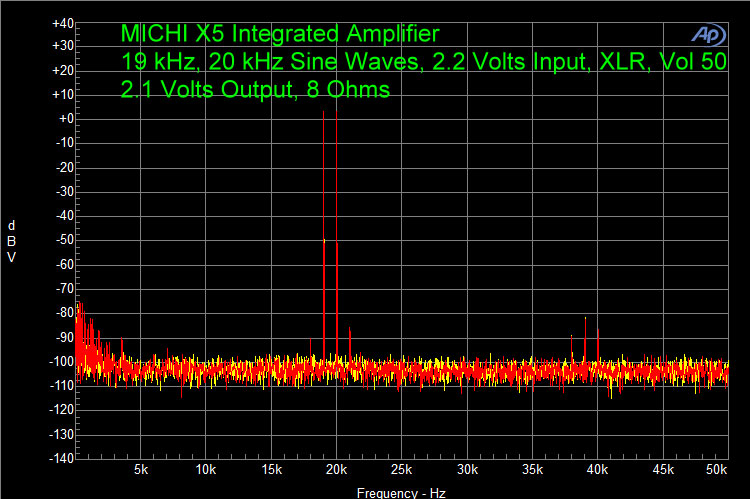
Raising the output to 20 Volts results in a considerable increase in the IM side peaks.
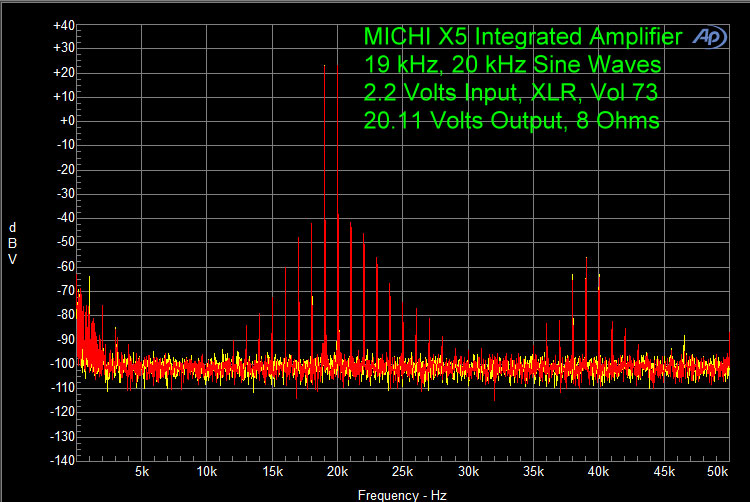
Changing the load to 4 Ohms, 2 Volts output, gives two more visible side peaks around the test signal peaks. Keep in mind that it is the same voltage output, but twice the wattage since the load is 4 Ohms.
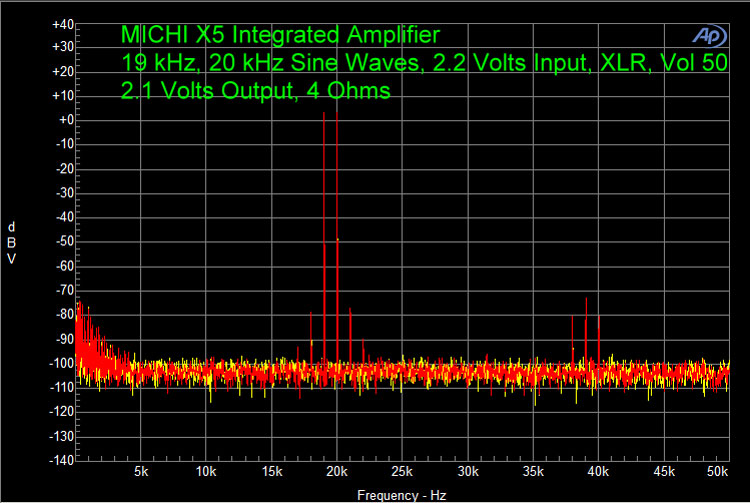
A 21 Volt output into 4 Ohms. A few more peaks in the 40 kHz area than with an 8 Ohm load. There is also more congestion at the base of the 19 kHz and 20 kHz input signal peaks.
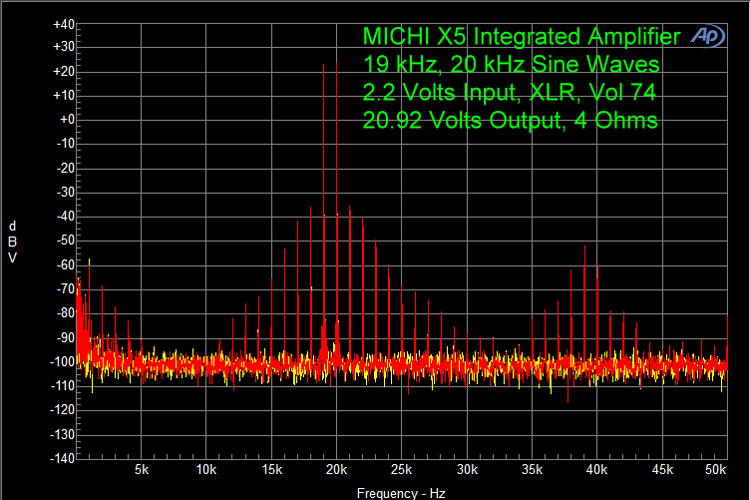
Let’s look at the IM peak at 1 kHz, which is 20 kHz minus 19 kHz.
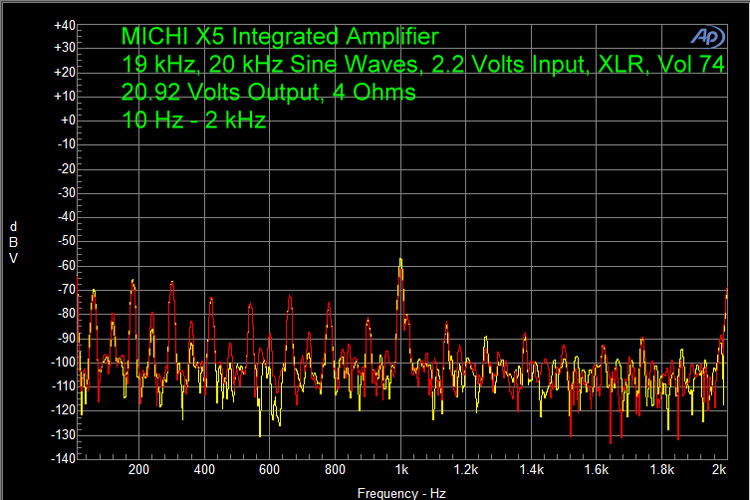
Because this might be confused with the hum peaks, here is the spectrum with the input voltage turned off. The 1 kHz IM peak is not there.
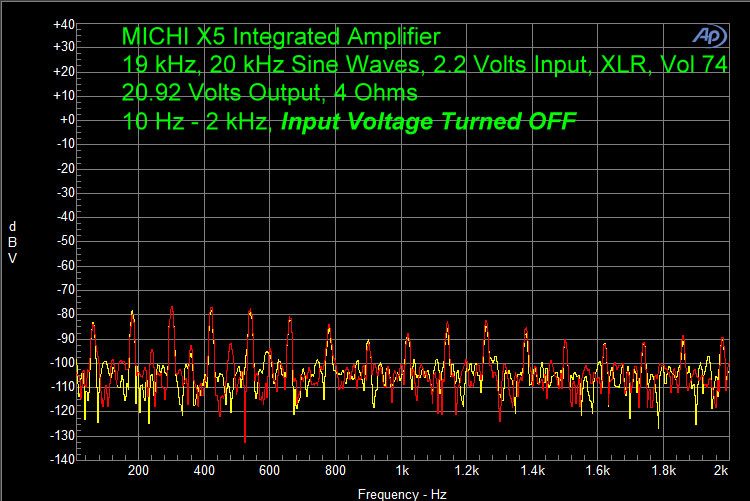
Here are some spectra using the standard 60 Hz, 7 kHz Intermodulation Distortion test signals.
First, 2.2 Volts output into 8 Ohms. Very low IM.
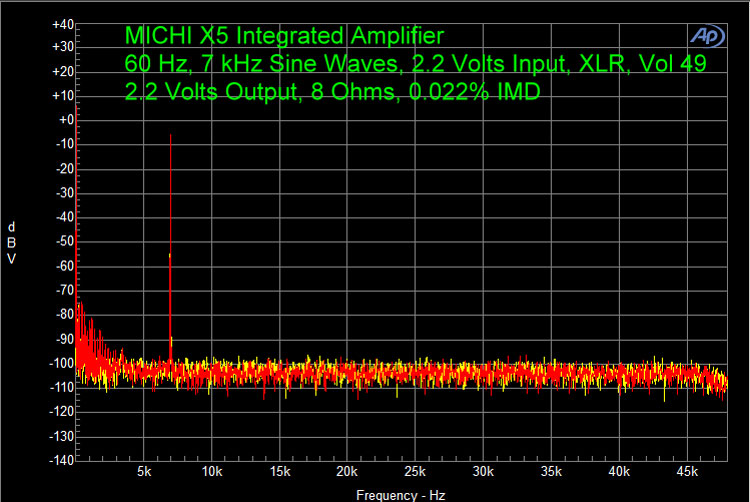
Raising the output to 20 Volts produces more IM, which is expected.
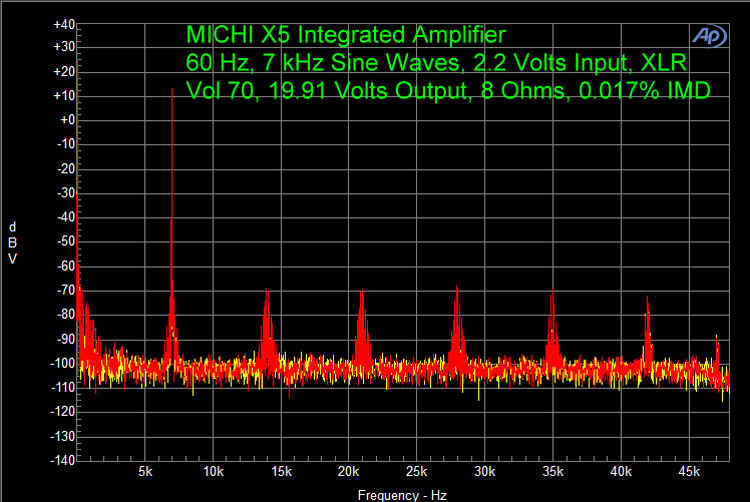
Using a 4 Ohm load at 2.2 Volts output delivers a bit more than at 8 Ohms, but even though it is the same output voltage, the wattage is doubled.
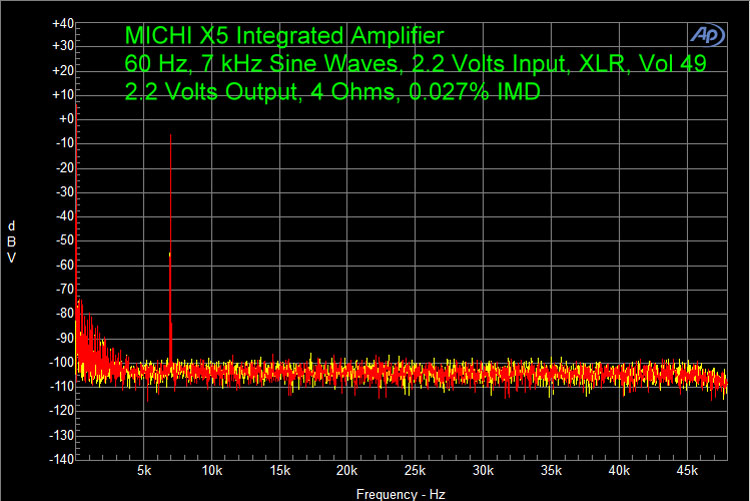
And, at 20 Volts output and a 4 Ohm load, the IM is almost double what it is at 8 Ohms. Again, it is twice the wattage (20 Volts at 4 Ohms is 100 watts).

THD+N vs. Frequency for an 8 Ohm load and two output voltage settings.
At 2.1 Volts output (1/2 watt), the spectrum stays flat throughout the 50 kHz band. At 20 Volts (50 watts), distortion rises starting at about 500 Hz. This is normal amplifier behavior.
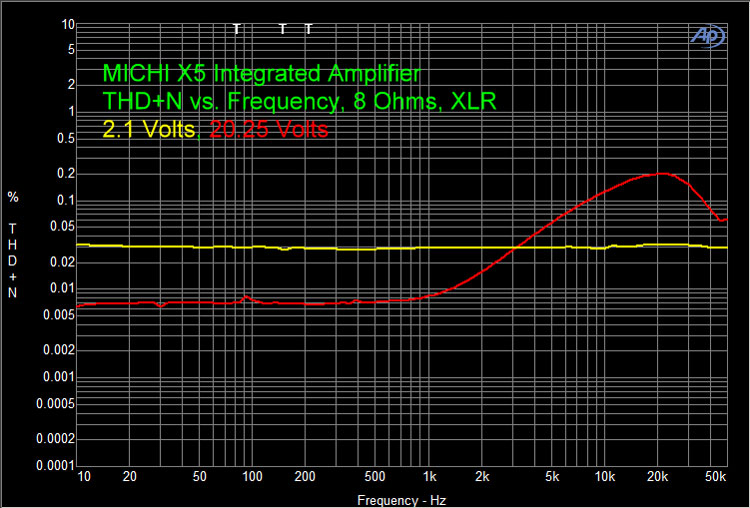
With a 4 Ohm load, we get about the same amount of distortion at low voltage, and somewhat more at a higher voltage (100 watts). The rise at higher frequencies is partly due to negative feedback which is employed for a variety of reasons and is present in practically all solid-state amplifiers.
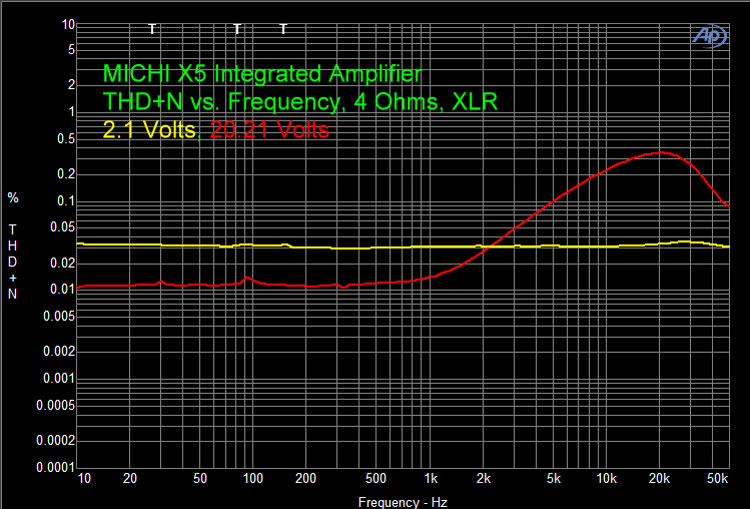
Here is a spectrum for THD+N vs. Power Output at an 8 Ohm load. The output at 1% THD+N (the point defined as clipping), is 350 watts, right on spec.
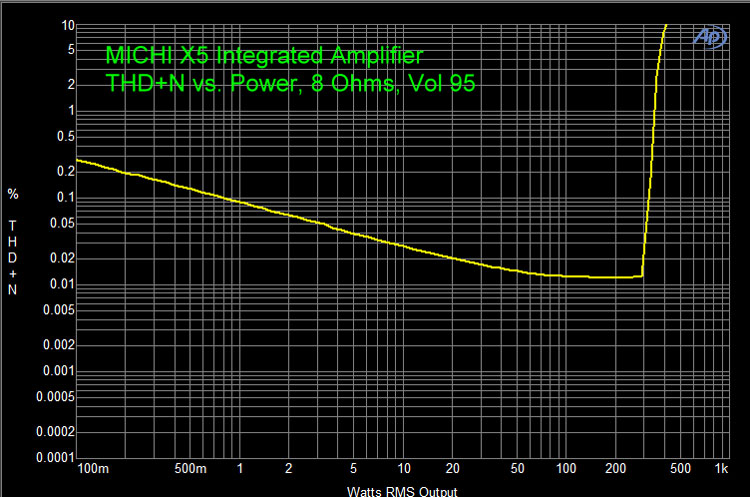
THD+N with a 4 Ohm load is shown below. Only one channel at a time is measured, so the output at 1% THD+N is 610 watts, which is a bit more than the rated output (600 watts).
The Frequency Response is shown below for an 8 Ohm load. You can see that with a low voltage output, the response is within 0.7 dB all the way out to 200 kHz. At the higher output, it begins to attenuate at about 50 kHz.
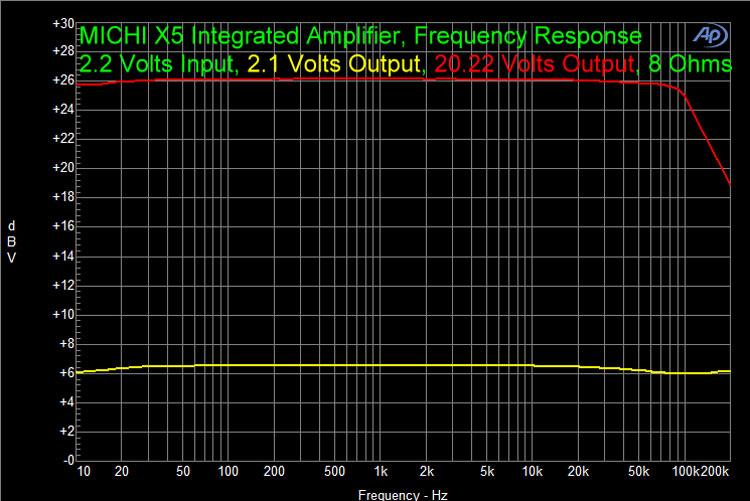
With a 4 Ohm load, see below. The low voltage response is within 1.2 dB to 200 kHz, and at higher voltage, it begins attenuation at 10 kHz.
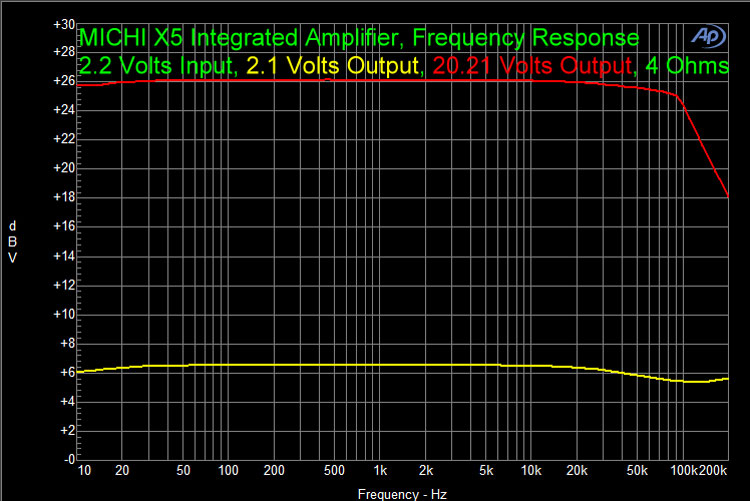
The MICHI X5 has a built-in phono preamplifier. I tested the Frequency Response RIAA accuracy for both the MM (Moving Magnet) and MC (Moving Coil) cartridge inputs. Here is the MM spectrum. The response is within 0.3 dB, 20 Hz to 20 kHz. The right channel output is a bit lower than the left channel. The MM input is for a range between 2 mV and 7 mV cartridge output, and the MC input is for a range of 0.25 mV to 5 mV.
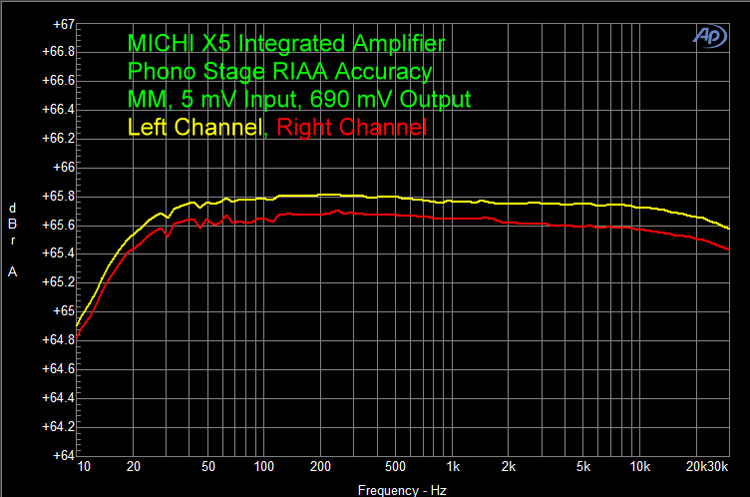
For the MC input, shown below. The response is the same. So, the X5 phono preamp exhibits excellent RIAA accuracy. This is important because, with vinyl LPs, low frequencies are attenuated, and high frequencies are augmented when the master lacquer is lathed (the lacquer is then metal plated and used to create the vinyl LPs by placing a block of vinyl on the plated master in a heated press, sort of like a waffle maker). During LP playback on a turntable, the phono preamplifier has to do the opposite, namely, augment the low frequencies and attenuate the high frequencies. This is done in accordance with the RIAA curve. The result has to be a flat frequency response. It’s all done with a series of capacitors and resistors in the phono preamplifier.

OK, so now we move on to the DAC. You can use this to decode the digital bitstream from your disc player or other digital sources. There are numerous digital inputs on the rear panel to take care of just about any need you have. I used the coax digital input (RCA jack) for the bench tests.
Here is the analog spectrum (decoded by the DAC) of a 1 kHz at 16/44.1 sampling, minus 5 dBFS. The output was 9.2 Volts into 8 Ohms. Distortion was 0.01%.
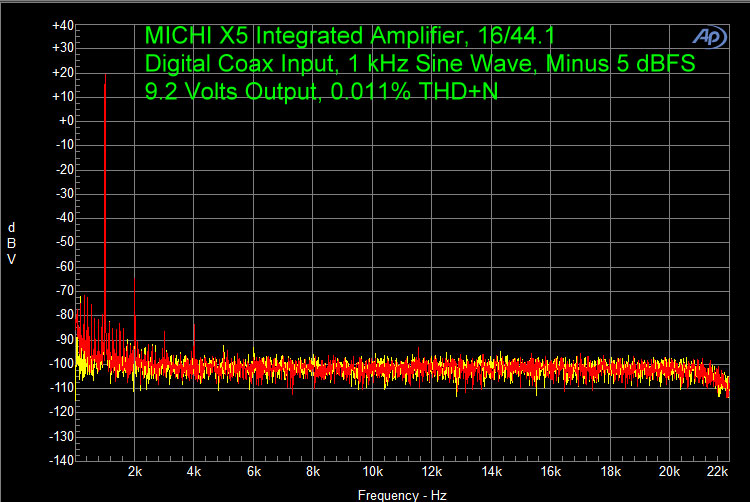
Now, the same signal but at 24/96 sampling. It looks pretty much the same as at 16/44.1. That is because it is using the same analog output stage. There is a bit of difference in the 2nd and 3rd harmonics, but this is spurious because those peaks are at such a low level (minus 80 to minus 90 dBV).
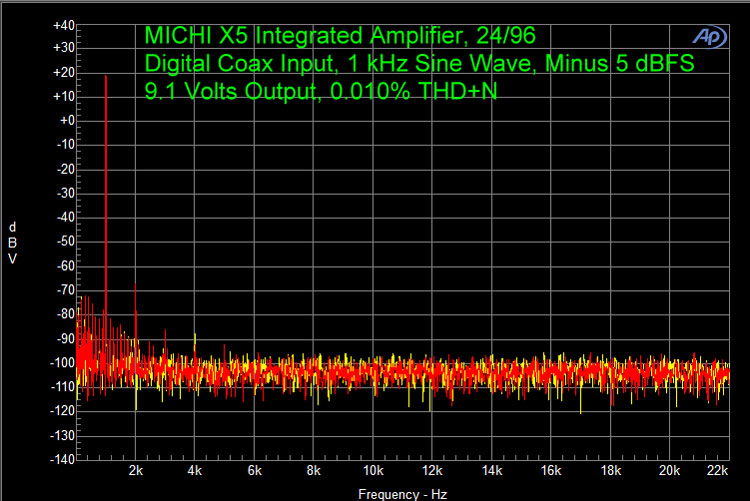
And, 24/192 sampling. Actually has a tiny bit more harmonics, but they do not show up in the number (0.01%), so again, this is spurious.

Jitter is an artifact that occurs in the digital bitstream. When the bits are zooming along in the stream, the DAC’s ability to decode them depends on the bits occurring at a very precise timing. If they occur a little too early or too late, the DAC decodes with errors. Modern DACs do a very good job, and jitter is not as much a problem as it used to be, but it still occurs.
Secrets Sponsor
Here are some tests of the MICHI X5’s decoding of a bitstream with a known amount of jitter added at a specific frequency (100 Hz).
First, the analog output (the DAC has decoded the digital bitstream) with no jitter added. I used 16/44.1 sampling.
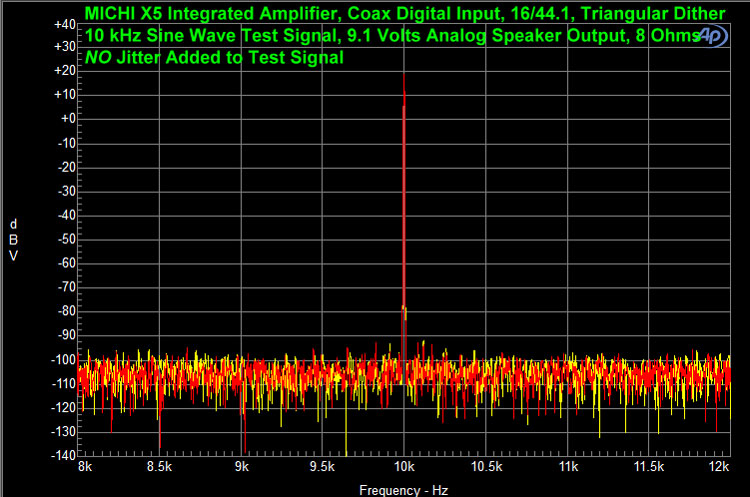
Now, compare the spectrum above to the one below where I added 266 picoseconds (psec) of 100 Hz jitter to a 10 kHz sine wave. You can see two peaks, one on either side of the 10 kHz sine wave at 9.9 kHz and 10.1 kHz (10 kHz minus 100 Hz and 10 kHz plus 100 Hz). That is a lot of jitter, more than one would likely encounter. I used this high amount to show what the effects are to the analog spectrum. I found this effect to occur at 24/96 sampling too, so high res does not exclude the effects of jitter.

Lowering the jitter to 89 psec resulted in no visible artifact peaks. So, as long as the jitter that is in the bitstream coming into the X5’s DAC is less than about 100 psec, there will not be a problem. Jitter can be reduced to almost zero if the DAC re-clocks the bitstream, but that feature is reserved for very high-end (very expensive) outboard DACs.

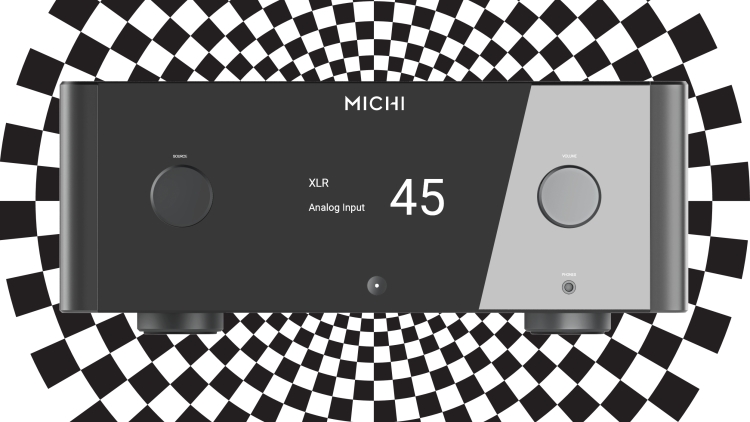
Rotel has made an auspicious return to the high-end audio market with the relaunch of MICHI. And the Rotel MICHI X5 Integrated amplified both looks and sounds suitably superb.
- High power
- Variety of inputs
- Excellent performance
- Value
- Nice remote control
- Additional phono input stage
- DAC reclocking
- Larger text labels on rear panel
- Two pairs of XLR inputs
- Tone control presets
The MICHI X5 is a very competitive integrated amplifier in the high-end market. It is full-featured and performs well within its price range. It has the power to drive any known speakers. A very musical sound will make this product attractive to a lot of consumers


